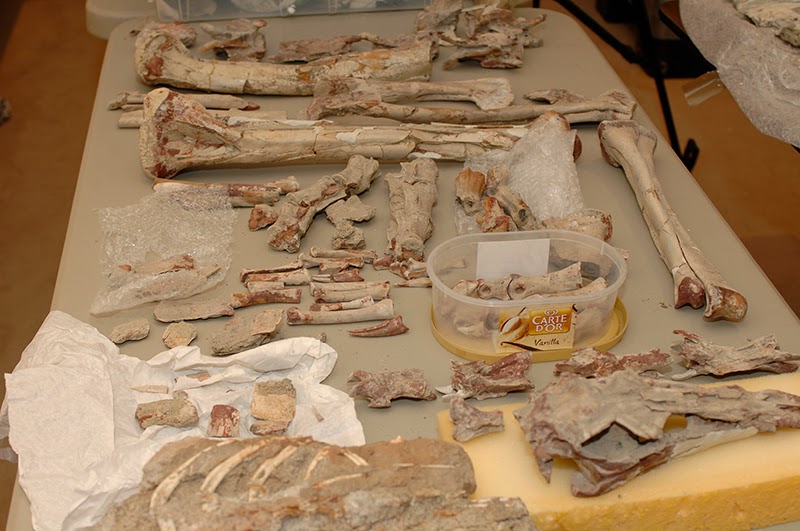Cultural property attorneys should inform their dealer and collector clients that due diligence and a transparent marketplace are necessary to steer clear of contraband heritage that is offered for sale. That is an important lesson taught by the cases of U.S. v. Eric Prokopi and United States v. One Tyrannosaurus Bataar Skeleton.
The companion cases involved the criminal prosecution of Prokopi for fossil smuggling and the seizure and forfeiture of dinosaur bones. They allowed Manhattan’s top federal attorney on Thursday to repatriatean astonishing 18 trafficked dinosaur skeletons to the Mongolian people.
Prokopi’s cooperation helped to wrap up a two-year law enforcement investigation into fossil trafficking networks, which stripped irreplaceable paleontological evidence from the Gobi Desert and inserted black market fossils into the stream of legitimate commerce.
 |
Some of the paleontological material returned to Mongolia
by U.S. officials last week. Courtesy ICE |
The items returned included the bones of two Tyrannosaurus bataars. Federal officials repatriated another virtually complete Tyrannosaurus bataar last year following Prokopi’s 2012
guilty plea to conspiracy, unlawful import of goods by means of false statements, and transportation of goods converted and taken by fraud.The cases remind observers that even though a seller may claim to offer artifacts legally, that does not necessarily mean the goods are legitimate. They must be checked out.
To discover the truth about whether artifacts have been stolen, illegally exported, or smuggled requires buyers and the marketplace as a whole to ask pointed questions and to demand credible documentation. That is why finding out where cultural objects originated from and obtaining their shipping and import documents must be an important function of cultural property attorneys who advise dealers and collectors about due diligence. To counsel clients otherwise may be unwise.
For example, Prokopi’s lawyers in the federal forfeiture case told the court in 2012 that government officials and “a media campaign stirred up by academic paleontologists” combined to unjustly target their small business clients. The attorneys, who regularly represent the interests of ancient coin dealers and collectors, wrotein pleadings filed with the court that the “commercial paleontologist” properly bought fossil bones on the open market, devoted time and expense to restoring and mounting the bones and, for this trouble, was unfairly targeted by the justice system.
They raised claimssimilar to those used to bolster the undocumented transnational trade of ancient coin artifacts:
- The dinosaur bones were not stolen.
- U.S. officials failed to publish proper country of origin and valuation rules for fossils.
- The bones could not be proven to have actually originated from Mongolia.
- It could not be proven that the bones were taken without the Mongolian government’s permission.
- Mongolian law was ambiguous and unenforced.
Despite the arguments, the cases resulted in the production of information verifying that the fossils were in fact stolen, smuggled, and bound for the highest bidders, presumably to be bought by individuals who would not ask where the objects came from or how they made their way to the market. That prompted Homeland Security Investigation’s Special Agent-in-Charge James Hayes, Jr., to issue a statement last week warning that “HSI will not allow the illicit greed of some to trump the cultural history of an entire nation.”
Cultural property lawyers can help dealers and collectors avoid entanglements with heritage traffickers and their illegal goods by promoting
strict due diligence practices to investigate the origins and transportation of cultural artifacts. Attorneys can also take the lead to protect cultural heritage by supporting legislative reforms that would shine a spotlight on the black trade. This would be a significant step in the right direction now that the fossil smuggling cases in New York have come to a successful conclusion.
By Rick St. Hilaire Text copyrighted 2010-2014 by Ricardo A. St. Hilaire, Attorney & Counselor at Law, PLLC. Blog url: culturalheritagelawyer.blogspot.com. Any unauthorized reproduction or retransmission of this post without the express written consent of CHL is prohibited.
©2010-2022 Cultural Heritage Lawyer Rick St. Hilaire. Content discussing cultural heritage law, art law, looted antiquities, stolen artifacts, and museum risk management that is general information only, not legal advice.


